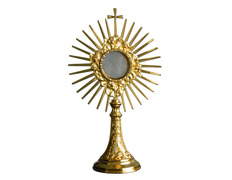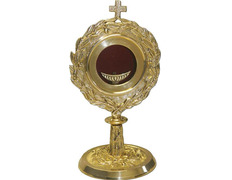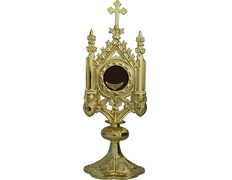Among the pieces of Catholic metalware, it is worth highlighting the role played by Catholic monstrances. The Catholic monstrances role is especially relevant in the celebration of the Corpus Christi festival. According to some authors, monstrance can be identified with the ostensorium (from the Latin ostentāre, "to show"). Other sources differentiate the custody of the monstrance based on the complexity and size of the piece. Be that as it may, both are sacred vessels whose function is to house or deposit the Blessed Sacrament , after being consecrated.
Thus, the consecrated Form or Host can be seen by the faithful in moments of adoration (Exposition of the Blessed Sacrament) and during Eucharistic processions.
There is a wide variety of sizes, styles and materials in the monstrances. It implies that there is a wide range of sale prices. It is a throne of glory for Our Lord, so it is tried to be worthy and beautiful.
The Catholic monstrances have their origin in the institution of the festival called Corpus. Corpus Christi means "Body of Christ" in Latin. On this feast, all Christians celebrate the transubstantiation of bread and wine into the Body and Blood of Our Lord Jesus Christ. Corpus Christi is the feast of the Blood and Body of Jesus. The feast of Corpus Christi commemorates the establishment of the Holy Eucharist by Jesus during the celebration of the Last Supper with all his disciples. The Blessed Sacrament is worthy of public worship because Jesus is present.
Through the feast of Corpus Christi, we commemorate the passion, death and resurrection of our Savior Jesus Christ. The celebration of Corpus Christi is the Thursday after the Solemnity of the Holy Trinity (the Sunday after Pentecost). In other words, we celebrate Corpus Christi 60 days after Holy Thursday. In some places, for various reasons, the celebration has been moved to the Sunday after, that is, 60 days after Easter Sunday.
The Blessed Sacrament is the most important part of the feast of Corpus Christi. It is displayed for public worship in a Catholic monstrance. The Blessed Sacrament is exposed in Churches and Parishes and goes out in procession through the streets of the cities. In many places, the streets and buildings are decorated with flags, flowers, tapestries, etc… to commemorate a day as important as Corpus Christi. The celebrations of Corpus Christi in Toledo and Corpus Christi in Valencia (Spain) are especially significant. Both celebrations have centuries of history.
We have to look for The origin of the celebration of Corpus Christi in 1246. This year, Robert de Thorete, Bishop of Liège, after meeting Saint Juliana de Mont Cornillon, proclaims the celebration of Corpus Christi in his Diocese. Bishop Roberto did not get to celebrate the party that he had created since he died shortly after. Despite the death of the Bishop, in the year 1247, Corpus Christi is celebrated for the first time on the Thursday after the feast of the Holy Trinity.
In the year 1264, Pope Urban IV, who had also known Saint Juliana of Mont Cornillon and knew firsthand of the events known as the Miracle of Bolsena-Orvieto , published the bull “Transiturus”. Through this bull, he establishes the feast of "Corpus Christi", keeping as the date for the solemnity the Thursday after Sunday of the Holy Trinity. Despite its proclamation, the feast of Corpus Christi does not transcend as the Pope wished. Its celebration is limited to minimal areas.
It will be in the year 1311 when the celebration of Corpus receives a new impetus from the hand of Clement V. The Pope publishes a new decree in which he orders the adoption of the festival. From this moment, aided by the compilation of laws promulgated by John XXII, the feast of Corpus Christi was established throughout the Church. His celebration quickly spread, reaching all corners of the world. Two historical figures are essential to understand the origin and importance of the Corpus Christi festival: Saint Juliana of Mont Cornillon and Father Peter of Prague.
At that time, the custom of exposing the Blessed Sacrament is introduced. For this, a glass equipped with glass was needed. At first, images, crosses, reliquaries, ciboriums and pyxes were probably used for this object. Despite this, the need to build vessels specially designed for this purpose was soon felt. Catholic monstrances to expose the Blessed Sacrament in the celebrations of Corpus Christi.
Even considering those mentioned above, it is extraordinary to find documentation on the existence of Catholic monstrances, with the characteristics with which we currently know them, before the 14th century. In this century, the elaboration of monstrances experiences a great impulse motivated by the institution of the Corpus Christi procession that is generalized and solemnized. Towards the end of the 14th century, abundant documentation on monstrances and religious monstrances can already be found.
Among the oldest monstrances, those of the Gothic style monstrances stand out, forged as a polygonal tower and cusp, with small glass windows, of which we have examples in Bari and Molfetta; others were made up of images of the Virgin with the Child Jesus or of Christ, who placed the Holy Host inside a glass on his chest or forehead.
From the middle of the 15th century it took the form of a turret or ogival temple (almost always made of silver) bristling with pinnacles. Catholic monstrances were generally supported by an artistic base, with a lunula or virile silver or gold in the middle to place the host visibly in it.
During the 15th and 16th centuries, competition began in many countries to possess monstrances of monumental proportions: such as the ark-monstrance of the Duomo of Genoa , a distinguished Renaissance work (1553), and which needed eight priests to be processed.
Among all the Catholic monstrances of the time, those of Spain stand out, most over 3 meters high, of extraordinary sumptuousness and beauty. In France and Germany, Eucharistic chapels multiplied at this time, with large monstrances visible through bars. The faithful could visit and contemplate the Blessed Sacrament in these chapels. In the Renaissance period, they were also built in the form of a bandstand but in a Roman style.
From the end of the 16th century, the ones that are more in use today in the form of a radiant sun began to appear, which since the 18th century have had circles of angels' heads surrounding the central virile.
As mentioned before, the most significant and most artistic processional monstrances in the world are found in the cathedrals of Spain . Among them, those of the Arfe family stand out. Enrique de Arfe is the author of what is probably the most famous, the custody of Toledo. His grandson, Juan de Arfe, sculpted the monstrance of Ávila (with flattened forms), the monstrance of Seville (which measures more than three meters and has theology as its theme) and the monstrance of Valladolid , called "of Adam and Eve in the Garden of Eden", because it is the scene that appears in his lower body. The custody of Valenzuela (Córdoba) stands out for its lower body and for being the oldest in the region.
Other Spanish Catholic monstrances to highlight are the Gothic-style monstrances: The Vich monstrance dating from 1413, the monstrance of the Baeza Cathedral, made with the donations of silver cutlery from the people of Baeza after the disappearance of the previous one in a fire in the SI Cathedral of Baeza in 1691. The monstrance of Barcelona with its impressive rhinestones. The custody of Cádiz that measures four meters The major custody of Córdoba, Gerona, León, Palma de Mallorca, Salamanca, Sahagún, Toro and Zamora.
Monstrances of classical or Renaissance style : The major monstrances of Alarcón (Cuenca), another in Cádiz, Jaén, Palencia, Santiago, Segovia, Seville (two), Teruel, Valladolid and Zaragoza.
Baroque style monstrances: The processional Monstrance of the Corpus of Murcia Cathedral , the work of Antonio Pérez de Montalto, which is preserved and exhibited in the Cathedral Museum. Custody of the Spikes of Ramón Bergón.
Custodians outside of Spain , the colonial custodians of the Banco de la República Art Collection in Bogotá, Colombia are notable. One of them, popularly known as 'La Lechuga', made by José de Galaz in 1707, is adorned with 1,485 emeralds, 1 sapphire, 13 rubies, 28 diamonds, 62 baroque pearls and 168 amethysts.
Catholic monstrances for sale. Catholic monstrances are deeply related to the celebration of Corpus Christi and the exposition of the Blessed Sacrament. Variety Catholic monstrances with a wide range of characteristics and sale prices. From metal monstrances and monstrances with very cheap prices to bronze monstrances and monstrances with gold and silver baths with higher prices.

Ref: 0F1506CUE

Ref: 1F339

Ref: 1F354

Ref: 1F304

Ref: 1F333

Ref: 1F353

Ref: 0B361

Ref: 0B1702

Ref: 0F1507

Ref: 94F10566

Ref: 94F10537

Ref: 1F359

Ref: 0F1502

Ref: 0R1501

Ref: 0F1505

Ref: 0F1500

Ref: 1F300

Ref: 1R361

Ref: 1F349

Ref: 0F1405T

Ref: 121B004

Ref: 4F1050036

Ref: 121B003

Ref: 0F1504CU

Ref: 1F1352

Ref: 1F1353

Ref: 0F1508

Ref: 1F350

Ref: 1F356